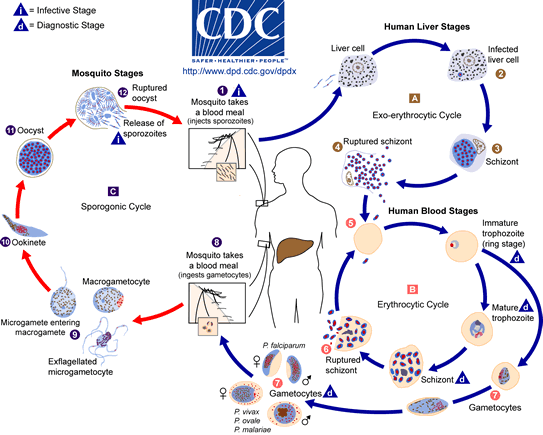Reproduction...without consent |
| * Table above is labeled as the life
cycle for Plasmodium vivax, this is a close relative of
falciparum and they share the same life cycle in all major steps.
The main difference between the two species, in regard to life cycle, is
that vivax does not attach to endothelial cells like
falciparum does, making it less deadly.
|
| Step - by - Step Assexual Life Cycle in the human host: |
|
1. P. falciparum enters the host in the form of a sporozoite through a bite from a female anopholes mosquito and enters the bloodstream. 2. The species enters the liver cells. There many reproduce asexually by dividing into schizonts that consist of many merozoites. Those who do not divide remain dormant in the liver where they can later become activated up to years later. This stage contains NO SYMPTOMS. 3. The merozoites contained in schizonts then flood to the red blood cells. 4, 5, and 6. Within 48 hours, enough merozoites have been formed to break out of the cell and start the process again. 7. Microgametocytes and macrogametocytes are formed to carry on the sexual life cycle.
|
| Step - by - Step Sexual Life Cycle in the mosquito vector: | |
|
8. The mosquito bites an infected human, during the bite it takes
in the microgametocytes and macrogametocytes.
9. Gametocytes develop into gametes through gametogenesis. 10. Fertilization occurs and the newly formed ookinete moves to the gut of the mosquito to develop into oocysts. 11. When fully developed the ookinete breaks free and sporogony takes place. 12. Thee ookinete bursts and sporozoites are released and later settle in the salivary glands.
The assexual human life cycle occurs when the mosquito next attacks! |
|
|
As can be seen, P. falciparum has a very complicated life cycle, which is one of the reasons it has been hard to create a vaccine. As mentioned earlier, some scientists view this multi-staged life cycle as a negative, while others hope that a weak link may offer a new chance at a proven vaccine. For more information on treatments and vaccines, visit Malaria.
|
|
| All information from this page was provided by the CDC's DPDx and Huestis, unless otherwise noted. |
